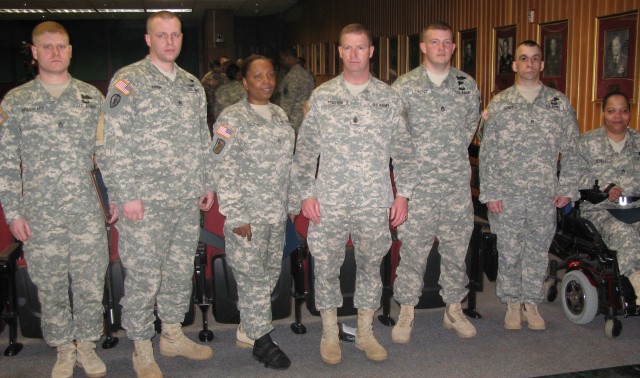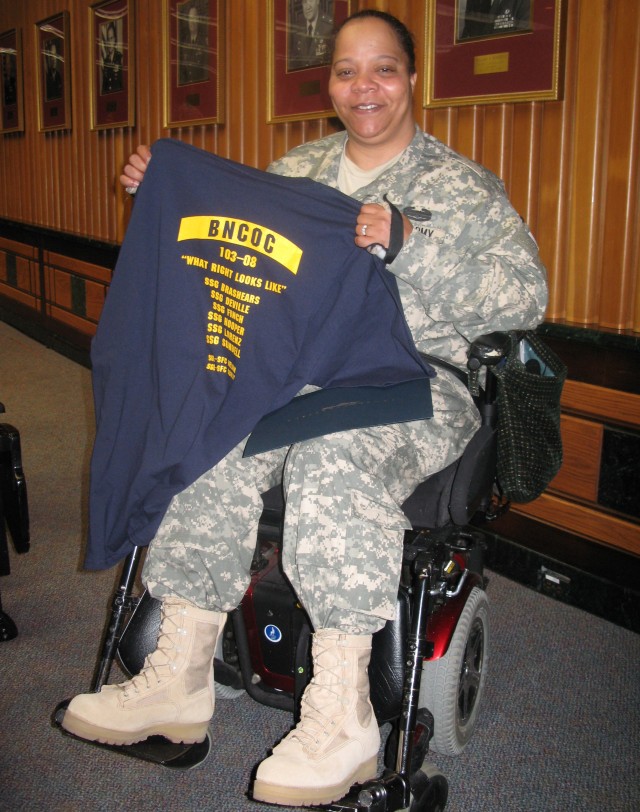WASHINGTON (Army News Service, March 28, 2008) -- Both wounded warriors and brigade cadre graduated Friday from the first-ever Warrior Transition Brigade Basic Noncommissioned Officer Course.
The BNCOC class at Walter Reed Army Medical Center is actually a pilot program, and it was born from an exchange of ideas between senior enlisted leaders and staff at: the Judge Advocate GeneralAca,!a,,cs Legal Center and School; Sgt. Maj. Brent Jorgenson of the Army Wounded Warrior Program; and Command Sgt. Maj. Jeffrey Hartless of the Warrior Transition Brigade at WRAMC. The pilot course is the first of its kind in the Army to be offered at a WTB.
The course was designed by Command Sgt. Maj. Shannon Boyer and Sgt. Maj. Rod Celestaine of TJAGLCS and their staff. The aim of the course is to conduct training to standard, with no special exceptions, said Sgt. 1st Class Barry Nelson, the senior small group leader at TJAGLCSAca,!a,,cs NCO Academy and one of two instructors for the WRAMC pilot.
Nelson added that all training and evaluations are conducted to the high standards set by the Army, just as if the students were attending a traditional academy.
The idea for the class made sense to both Nelson and fellow BNCOC instructor Sgt. 1st Class Theodore Scully. However, there had been initial concern about what kind of interest there would be from cadre and warriors in transition at the WTB.
The instructors were pleased to find that four Aca,!A"Warriors,Aca,!A? Staff Sgts. Renee Deville, Warren Finch, Dorothea Hooper and Eric Sundell, and two cadre members, Staff Sgts. Billy Brashears and Shad Lorenz, had signed on for the course, which kicked off March 10.
The course, like other Phase I BNCOCs, is academically heavy. It focuses on such issues as motivating subordinates, developing a cohesive team, troop leadership and cultural awareness. Students of the course successfully completed almost six hours of written exams which covered the gamut of small unit leadership skills. Students were also evaluated on drill and ceremony.
The question of whether the pilot course would be a "watered down" version of Phase I of BNCOC was answered day one by the instructors.
Aca,!A"There were times we would hear things like that from other cadre,Aca,!A? said Breshears, the course honor graduate. Breshears had already completed Phase II as an infantryman before being assigned as part of the WTB cadre. Aca,!A"It wasnAca,!a,,ct watered down at all, and every Army standard had to be met. The only difference was we did it at Walter Reed.Aca,!A?
On the first day of training, the instructors encouraged the students to discuss the stereotypes that existed about cadre and Warriors alike, said Finch, who has been a Soldier-patient at WRAMC for more than two years.
The free exchange of ideas allowed the NCOs to learn about cultural issues new to the Army, said Nelson.
Aca,!A"Folks are being returned to duty that are going to have special needs," he said. "In this environment, the students are being exposed to all of that, and they are learning how to handle those unique leadership challenges.Aca,!A?
Lorenz, an infantryman with the 101st Airborne Division before his cadre assignment, saw the course as more than a lesson in leadership development.
Aca,!A"The greatest thing possible was to train cadre and Warriors together," he said. "There was a division created by outside influences. This helped bring out our differences and we came to a greater understanding of each other.Aca,!A?
Finch, whose heart gave out during an ambush in Mosul, Iraq, went through the course with a pacemaker in his chest. He was taken to the emergency room twice, but was able to make up the lessons he missed during evening remedial classes. He found out prior to the start of the course that his Army career will end in a few months when he medically retires.
For Finch, completing the course was a personal goal, and reminded him who he really was.
Aca,!A"They really pushed us to see how far we could go," he said. "This class got those gears going again, and it set me up for success in my life as a civilian.Aca,!A?
Deville, who successfully completed every aspect of the course from a wheelchair -- including drill and ceremony -- exemplified the ArmyAca,!a,,cs Aca,!A"Warrior Ethos,Aca,!A? said Sgt. Maj. of the Army Kenneth O. Preston, who spoke to the Soldiers and audience at the graduation ceremony.
Preston also made note of Hooper, who had undergone surgery just prior to beginning the course, and tore her stitches during training. Preston pointed out that Sundell, who is headed back to regular duty soon, was always there for the other students, even though he was enduring his own rehabilitation.
Aca,!A"All six of the graduates hold a very special place in the Army,Aca,!A? Preston said. Aca,!A"They have helped set the tone and precedent for what I hope will be the future of the way noncommissioned officer education will go.Aca,!A?
Each Soldier took away something different from the program, but they agreed the program provided a link to the Army that is often missing in the rehabilitation and recovery worlds of an Army medical center.
Aca,!A"Being in this environment, away form the traditional Army, can be hard,Aca,!A? Lorenz said. Aca,!A"This course put things back in focus, it puts you where you need to be.Aca,!A?
Expansion of the pilot throughout the ArmyAca,!a,,cs WTBs is something that should be considered, say the instructors and students.
Aca,!A"We hoped to prove that we could conduct a successful course,Aca,!A? Scully said. Aca,!A"The Soldiers here proved they wanted to do this. With phenomenal support all around, and a lot of hard work on their part, they did.Aca,!A?
The groundbreaking graduates are now expected to take the lessons learned at BNCOC, and impart that knowledge through wise guidance as living examples of Army leadership, said Preston.
Aca,!A"When you look at loyalty and allegiance, by definition it means faithfulness to whatever one that weAca,!a,,cre tied to by duty, pledge or promise,Aca,!A? he said. Aca,!A"It is a personAca,!a,,cs willingness to devote their moral and intellectual resources big-heartedly and enthusiastically, which describes each and every one of you here today.Aca,!A?




Social Sharing